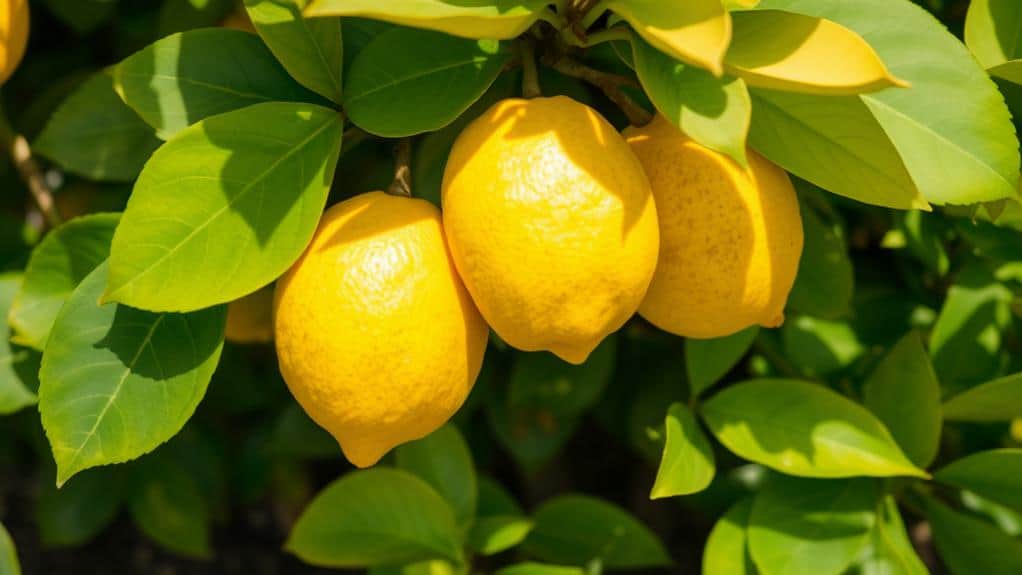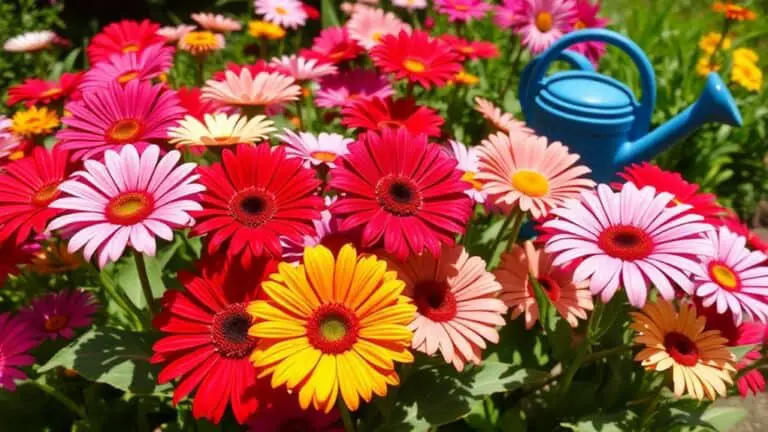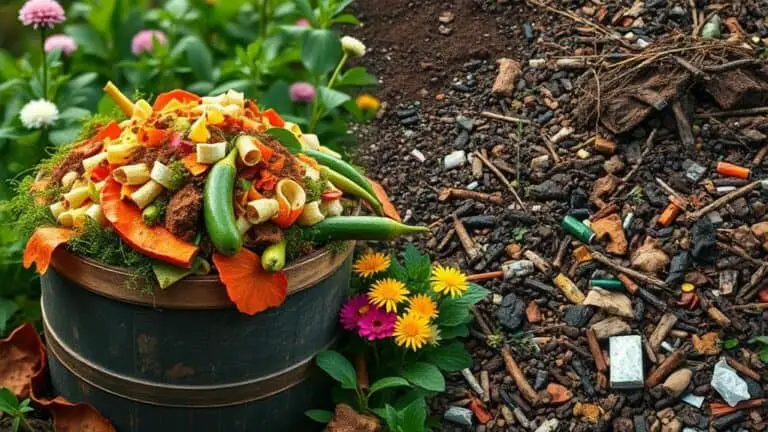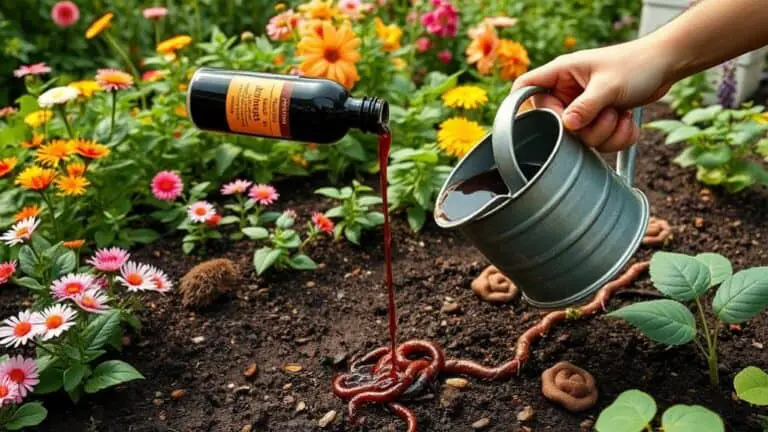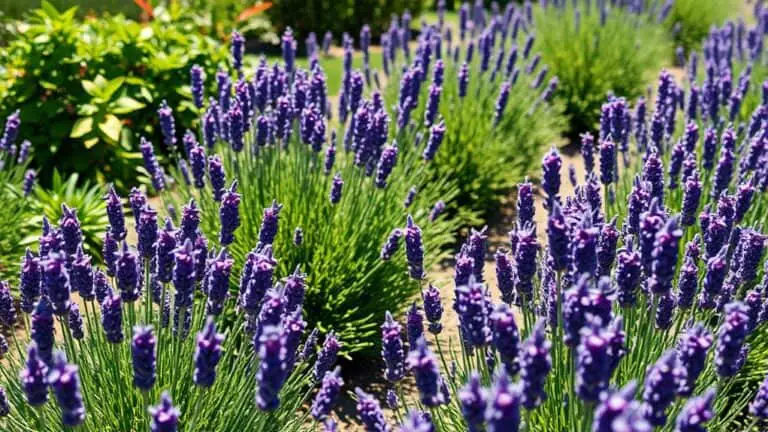Why Your Lemon Tree Leaves Are Turning Yellow
I've noticed my lemon tree's leaves turning yellow, and it's quite frustrating. I started looking into common causes and found that nutrient deficiencies, overwatering, and lack of sunlight could all be culprits. But how do you figure out which issue is affecting your tree? And what steps should you take to remedy the situation? There are several factors to take into account, and it's crucial to identify the right one so you can restore your tree to its former glory. Let's explore some potential reasons and solutions together.
Common Causes of Yellowing
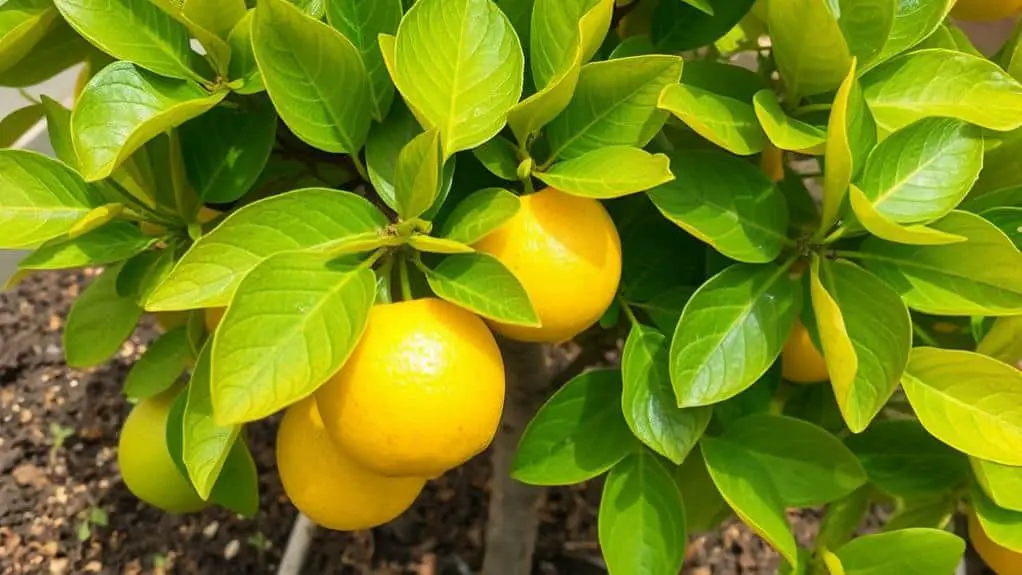
When lemon tree leaves start turning yellow, it's usually a sign that something's off. One common cause is nutrient deficiencies. If your tree isn't getting enough nitrogen or magnesium, the leaves can lose their vibrant green color.
Overwatering can also be a culprit. Too much water leads to root rot, which blocks nutrients from reaching the leaves.
Make sure your lemon tree gets plenty of sunlight—at least 8 hours daily. Without enough light, the leaves can turn yellow and the tree's health can decline.
Pests like spider mites and mealybugs can also cause yellowing by damaging the leaves.
Natural Leaf Shedding
Now, let's talk about natural leaf shedding in lemon trees.
It's completely normal for older leaves to turn yellow and fall off as part of their lifecycle, which usually lasts about 2-3 years.
This process helps the tree focus its energy on new growth and maintaining healthy, vibrant foliage, so don't worry if you see a few yellow leaves here and there.
Normal Leaf Lifecycle
Lemon trees naturally shed their older leaves as part of their growth cycle, typically every 2-3 years. Don't worry if you see some yellowing leaves; it's a normal part of the tree's life cycle. This natural shedding often starts at the bottom, signaling that these leaves have reached the end of their journey. Shedding typically happens in spring and summer, allowing the tree to focus energy on new growth. Here's a quick look:
| Stage | Leaf Color | Tree Focus |
|---|---|---|
| Early Life Cycle | Green | Energy Absorption |
| Mid Life Cycle | Light Green | Growth and Maturity |
| End Life Cycle | Yellow | Energy Conservation |
While a few yellow leaves are normal, excessive yellowing may indicate other issues.
Seasonal Leaf Drop
Seasonal leaf drop, or natural leaf shedding, is an intriguing aspect of a lemon tree's lifecycle.
It's perfectly normal for lemon trees to shed their older leaves, especially during fall or winter when growth slows. You might notice leaves turning yellow before they drop, which is a sign the tree is redirecting nutrients to new growth.
Here's what to keep in mind:
- Older leaves (2-3 years old) are the most likely to yellow and fall.
- It usually happens in cooler seasons.
- Regular shedding is a sign of a healthy lemon tree.
- Excessive yellowing might indicate other problems.
- Monitor the overall health of your tree to confirm it's just natural shedding.
This process keeps your lemon tree vibrant and growing strong!
Identifying Healthy Yellowing
While it's interesting to observe seasonal leaf drop as a natural part of a lemon tree's lifecycle, you might wonder how to distinguish healthy yellowing from potential issues. When the leaves yellow on the lower parts of the tree, it's often a sign of natural leaf shedding. This happens because the tree is redirecting nutrients to promote healthy new growth. Typically, mature leaves live for 2-3 years before yellowing and dropping.
Here's a quick comparison to help you identify healthy yellowing:
| Indicator | Healthy Yellowing |
|---|---|
| Yellowing location | Lower leaves |
| Affected leaf count | Few older leaves |
| Occurrence | During growth season |
| Tree's overall health | Remains vigorous |
If yellowing is localized, it's likely just the tree focusing on new, healthier foliage.
Signs of Overwatering
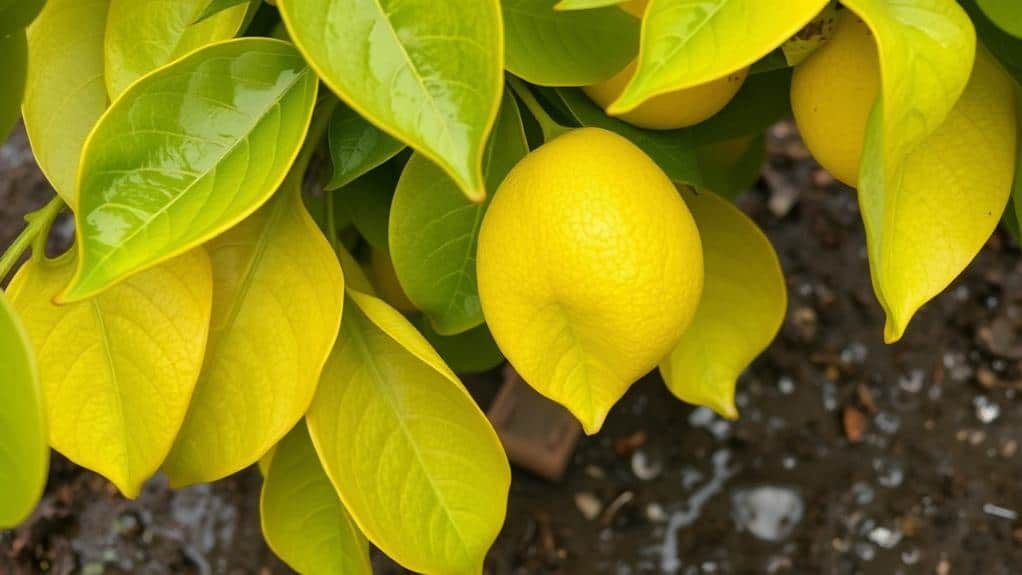
One of the telltale signs that you've been overwatering your lemon tree is the appearance of yellowing leaves and premature leaf drop.
When you overwater, the soil becomes soggy, diluting essential nutrients and causing root rot, which further leads to those dreaded yellow leaves.
Here are some clear signs of overwatering:
- Soggy soil: The soil feels consistently wet and dense.
- Root rot: Brown, mushy roots instead of firm, white ones.
- Nutrient deficiencies: Yellowing leaves despite regular fertilizing.
- Premature leaf drop: Leaves falling off earlier than expected.
- Standing water: Water pooling on the soil surface after watering.
To prevent this, let the top 2-3 inches of soil dry out before watering again.
Use well-draining soil and pots with adequate drainage holes.
Adjusting Light Exposure
Proper light exposure is essential for maintaining the lush, green leaves of your lemon tree. If your tree's leaves are turning yellow, it may not be getting enough sunlight.
Lemon trees thrive with about 12 hours of direct sunlight daily, but they can survive with at least 8 hours. Positioning your tree near south or west-facing windows will help guarantee ideal light exposure.
For immature trees, relocating them to sunnier spots can prevent yellowing leaves. Also, reducing shading from other plants can make a big difference.
During shorter winter days, using grow lights can supplement natural light. Making sure your lemon tree gets the right amount of light will keep its leaves vibrant and healthy.
Managing Nutrient Deficiency
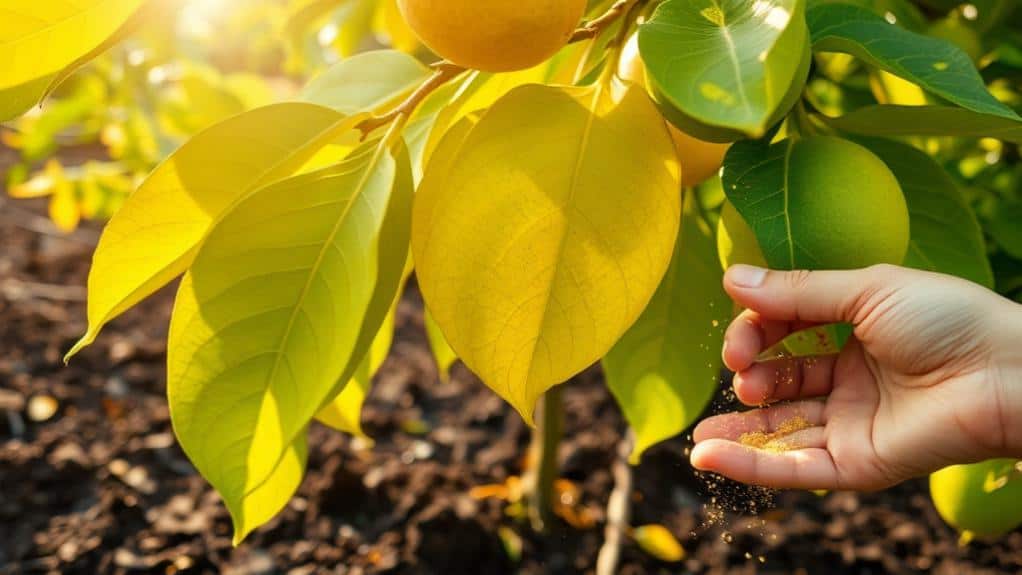
If you've noticed yellow leaves on your lemon tree, it might be a sign of nutrient deficiencies that we can easily address.
By recognizing shortages of essential nutrients like nitrogen, magnesium, or iron, and using targeted fertilization practices, we can help your tree thrive.
Monthly applications of a balanced citrus-specific fertilizer and occasional foliar feeding with magnesium-rich solutions can keep your tree healthy and its leaves vibrant.
Recognizing Nutrient Shortages
Yellowing leaves on lemon trees often signal a nutrient deficiency, with nitrogen being a common culprit.
When leaves turn yellow, it's crucial to recognize the specific nutrient deficiencies affecting your tree so you can address them effectively.
Here are some common signs to look out for:
- Nitrogen deficiency: Older leaves turn yellow as nutrients are redirected to new growth.
- Magnesium deficiency: Yellowing between leaf veins.
- Iron deficiency: New leaves turn yellow, but veins remain green.
- Zinc deficiency: New leaves become yellow and wrinkled.
- Manganese deficiency: Yellow spotting on leaves.
Fertilization Best Practices
When it comes to managing nutrient deficiencies in your lemon tree, fertilization best practices are key.
To keep your tree leaves green and healthy, apply a citrus-specific fertilizer monthly during spring and summer. This guarantees your tree gets essential nutrients like nitrogen and potassium.
Watch for yellowing leaves—they often signal a lack of nitrogen or magnesium. A slow-release fertilizer, such as Osmocote Fruit Citrus Trees and Shrubs Fertilizer, provides a steady nutrient supply, minimizing the risk of over-fertilization.
Regular soil tests help you understand nutrient levels and make informed adjustments.
For an organic touch, consider using compost or worm castings. These natural options enrich the soil and promote your lemon tree's growth.
Identifying Pests
Discovering the culprits behind your lemon tree's yellowing leaves often involves identifying pests that have taken residence. Common pest infestations like spider mites, aphids, and mealybugs could be the reason.
Spider mites, in particular, leave fine webbing on the undersides of leaves, making them easier to spot. Regularly inspecting your lemon tree, especially the undersides of leaves, is essential.
Here are some specific signs to look for:
- Aphids: Small, green or black insects on new growth.
- Spider mites: Tiny, red or brown dots with fine webbing.
- Mealybugs: White, cottony clusters at leaf joints.
- Yellowing leaves: Often the first visible sign of a problem.
- Sticky residue: Left behind by sap-sucking pests.
Effective Pest Control
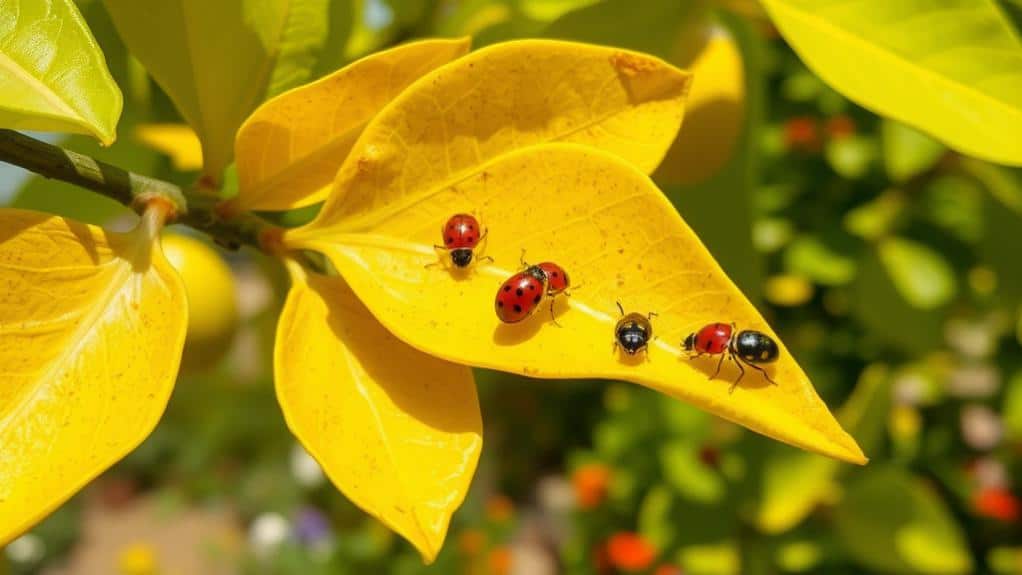
Noticing pests on your lemon tree can be alarming, but there are effective ways to combat them and restore your tree's health.
Regularly inspecting your tree helps spot common pests like aphids, spider mites, and mealybugs, which can cause yellowing leaves. I recommend using neem oil or insecticidal soap as treatments for pest infestations. Just follow the package instructions for the best results.
Quarantining affected plants is essential to prevent pests from spreading to healthy trees in your garden. Additionally, keeping your tree healthy with proper watering, light exposure, and nutrients helps deter pest infestations.
Don't forget to monitor for mold or mildew, as poor air circulation can make your tree more vulnerable to pests and diseases.
Proper Watering Techniques
When it comes to watering your lemon tree, it's all about balance.
You'll want to water deeply but not too often, letting the top 2-3 inches of soil dry out between sessions to avoid root rot.
Make sure your pot has good drainage and check soil moisture regularly with a finger or moisture meter to keep your tree happy and healthy.
Soil Moisture Levels
Proper watering techniques are essential for maintaining healthy lemon trees, especially when it comes to soil moisture levels. Overwatering and underwatering are common issues that can cause lemon trees' leaves to turn yellow.
To keep your tree happy, follow these tips:
- Check Soil Moisture: Use a moisture meter or insert your finger 2-3 inches into the soil.
- Let Soil Dry Out: Verify the top layer of soil dries before the next watering.
- Use Well-Draining Soil: This prevents water accumulation and root rot.
- Adequate Drainage: Verify pots have drainage holes to avoid stagnant water.
- Adjust for Environment: Consider temperature and humidity, which affect soil moisture.
Watering Frequency Guidelines
Watering lemon trees correctly can be tricky, but it's essential for their health and vibrancy. You need to water deeply and infrequently, letting the top 2-3 inches of soil dry out between sessions. This helps prevent yellow leaves caused by too much water, which can lead to root rot.
During their active growth in spring and summer, you'll need to water more often than in the dormant winter months.
Always check the soil moisture before watering. A moisture meter or even just your finger can help you decide if it's time. Overwatering can dilute nutrients, causing stress and yellowing leaves.
Drainage Importance Highlights
A key factor in preventing your lemon tree's leaves from turning yellow is ensuring proper drainage. Without it, water can accumulate, leading to root rot and unhealthy, yellowing leaves.
Here are some tips to help:
- Use pots with drainage holes to let excess water escape.
- Choose a well-draining soil mix, like citrus potting mix.
- Follow a watering schedule that lets the top 2-3 inches of soil dry out between waterings.
- Regularly check soil moisture with a moisture meter or by testing with your finger.
- Avoid letting the pot sit in standing water.
Seasonal Care Tips
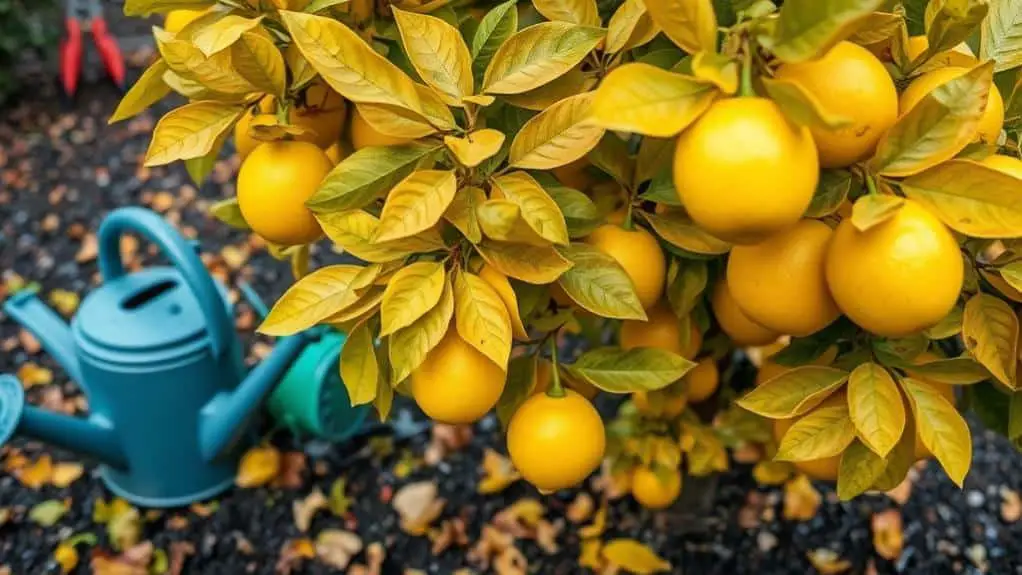
As the seasons change, our lemon trees require specific care to stay healthy and vibrant.
In spring and summer, I make sure to fertilize monthly to support new growth and prevent nutrient deficiencies.
When fall and winter roll around, it's essential to adjust our care routine. I reduce watering frequency to avoid root rot, as lemon trees are less active in cold weather.
Ensuring the leaves on your lemon tree are getting enough light is also important; moving the tree closer to south or west-facing windows helps.
To maintain proper humidity levels between 40-60%, I use pebble trays or humidifiers.
Regularly inspecting for pests is also key, as increased indoor warmth can attract them, leading to yellowing leaves.
Environmental Stress Factors
While seasonal care is essential for keeping lemon trees healthy, maintaining ideal environmental conditions is just as important.
Lemon tree leaves can turn yellow due to various environmental stress factors. Here are some key considerations:
- Temperature Fluctuations: Keep the temperature between 65°F and 75°F.
- Light Exposure: Guarantee at least 8 hours of direct sunlight daily.
- Humidity Levels: Maintain humidity between 40-60%.
- Air Circulation: Good air flow prevents fungal diseases and pest infestations.
- Environmental Changes: Avoid sudden changes like moving the tree indoors or to a shaded area.
Frequently Asked Questions
How to Fix Yellow Leaves on a Lemon Tree?
To fix yellow leaves on a lemon tree, I first check for nutrient deficiency and apply a citrus-specific fertilizer. I also inspect for pest infestation, adjust watering practices, increase sunlight, and prune yellow leaves to encourage new growth.
How Often Should I Water a Lemon Tree?
I water my lemon tree every 1-2 weeks, adjusting for the season. During lemon tree care, I guarantee proper soil drainage by using pots with drainage holes. Checking soil moisture helps maintain a consistent watering schedule.
How to Stop Leaves From Turning Yellow?
To stop leaves from turning yellow, I check for nutrient deficiencies and guarantee my lemon tree gets enough light. I also inspect for pest infestations and treat them promptly. Proper watering and good air circulation are essential.
What Does Overwatered Lemon Tree Look Like?
When I overwater my lemon tree, the symptoms include yellowing leaves, wilting or drooping foliage, and a sour smell from the soil. Root rot often accompanies these signs, with mushy roots and soft-textured leaves being clear indicators.
Conclusion
So, if your lemon tree's leaves are turning yellow, don't worry too much! By checking for natural shedding, ensuring it gets enough light, managing pests, and providing the right nutrients and water, you can get it back to health. Remember, a little attention goes a long way. Keep an eye on your tree, and you'll be enjoying lush, green leaves in no time. You've got this, and happy gardening!

